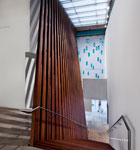1. Understand the concept
Green façades—planted exterior walls and living roofs—are becoming popular as a means of insulating buildings and collecting storm water. Increasingly, these plant walls are also finding a place indoors. “Biowalls are planted elevations either outdoors on façades or indoors,” Furbish says. “Most of our work to date has been indoor installations.”
2. Consider the objective
Biowalls provide a spectrum of benefits. “People are drawn to beautiful plants,” Furbish says. “When they walk into a room and see a planted wall, there’s a wow factor. Plants can be calming and relaxing, too, providing psychological benefit to the aesthetics.”
Plants are also highly effective air filters, and that’s part of the reason Baltimore-based Under Armour added a biowall to its program of sustainable business practices and building elements.
3. Choose a structure
There are three basic ways to build a biowall. One is to replicate what normally happens on the ground—with root mass embedded in soil but on a vertical surface. Another method is hydroponics, where plants are grown in water without soil. A third method is aeroponics, where plants grow in misted air.
An important factor to consider is that soil is heavy, requiring an engineered structure to support the weight. Hydroponics requires less of a structural system, and aeroponics requires a different way of moving water and air.
“Our biowalls at the moment are all hydroponics,” Furbish says. “We favor lighter engineering, and we’re trying to design systems with less maintenance and structure.” He adds that hydroponics allows better control of the root mass’s condition than is possible with soil. “The key to success is to keep the root zones within healthy parameters,” he says.
4. Choose a location
There are no size or location restrictions for biowalls. The biowall at Under Armour is 25’ x 25’, but Furbish has built biowalls that are three stories tall.
“Whatever the size, it requires the same infrastructure,” Furbish says. “The key is to be able to get access to manage the plant-root zone.”
Under Armour located its biowall in its headquarters’s cafeteria. “They wanted to showcase this innovative green technology,” Furbish says.
5. Choose organic material
Furbish Company has a long list of tropical houseplants that are well suited for biowalls, ranging from green Algerian ivy to leafy Philodendrons and blooming Phalaenopses. The final choice is based on what will work with the existing elements of the specific setting, including the space’s light and its desired aesthetic.
“The Under Armour biowall features a tight, low-growing cover as opposed to an organic canopy hanging out from the wall,” Furbish says. The biowall is planted with Pilea cadierei, Selaginella ficus, fetonia, and Strobilanthes.
6. Build the wall
The biowall at Under Armour is on an existing wall, which is the starting point for most installations. A frame made of waterproof panels is added to the wall, a capillary fabric is stretched over the frame, and the plants are inserted.
“The fabric is designed to wick the moisture, and it’s strong enough to hold the root and the body of the plants,” Furbish says. An irrigation system at the top of the wall distributes water, gravity carries it down the wall through the plants, and a basin at the bottom collects and recirculates it.
 7. Maintain the wall
7. Maintain the wall
With appropriate plants for the location and controlled water quality and light levels, a biowall needs minimal attention. “The goal is to have the maintenance be predominantly pruning back plants that are going crazy,” Furbish says.
Furbish Company doesn’t install a wall and then leave. “We’re happy to train our clients to maintain the wall, but we’ve paid our dues, and we’ve learned how to manage system conditions, and so we like to leverage that learning,” Furbish says. “For that reason, we maintain it ourselves until it is at least stabilized and the client can do the leg work.” ABQ
 7. Maintain the wall
7. Maintain the wall

